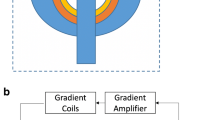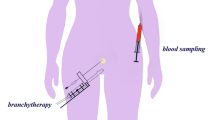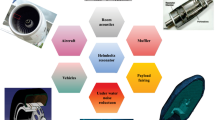Abstract
Purpose
Focused ultrasound (FUS) has been studied extensively in the medical field for tissue ablation, neuromodulation, and medication administration. The present proposal investigates the influence of frequency and skull geometry on acoustic transmission through the human temporal fossa by using single-element immersion ultrasound transducers to verify the acoustic map pressure generated by the deformation of acoustic waves.
Methods
A needle-type hydrophone with a 1-mm tip attached to a computed guided 3D axis system was used to characterize the aberrations induced by a human skull in a water tank. A planar ultrasound transducer with a central frequency of 0.4 MHz and a focused transducer with a central frequency of 1.7 MHz, both targeting the beam through the human temporal bone, was used to create the acoustic pressure profile maps.
Results
The results show that by focusing acoustic waves in the temporal bone, a planar transducer can be focalized by passing through the skull, creating a maximum focal pressure of 236.1 kPa, and a focused ultrasound transducer with a higher central frequency than those reported in the literature for human neurostimulation protocols can generate an acoustic map with a maximum focal pressure of 24.1 kPa.
Conclusion
These experiments have demonstrated that the skull behaves as an acoustic lens, concentrating and attenuating the acoustic beam as it passes through. This study also proposes that a single-element focused ultrasound transducer with a center frequency of 1.7 MHz may be useful for non-invasive transcranial ultrasound applications. This finding could improve the effectiveness of transcranial ultrasound applications.





Similar content being viewed by others
References
Blackmore J, Shrivastava S, Sallet J, Butler CR, Cleveland RO. Ultrasound neuromodulation: a review of results, mechanisms and safety. Ultrasound Med Biol. 2019. https://doi.org/10.1016/J.ULTRASMEDBIO.2018.12.015.
De Andrade P, Kamimura H, Costa E. Numerical Simulation of Transcranial Focused Ultrasound Based on Head CT Images. 2021. https://doi.org/10.1117/12.2605551,12088,503-510.10.1117/12.2605551.
di Biase L, Falato E, Di Lazzaro V, Bologna M, Kim H, di Biase L, Falato E, Lazzaro VD, Di Lazzaro V. Transcranial focused ultrasound (tFUS) and transcranial unfocused ultrasound (tUS) neuromodulation: from theoretical principles to stimulation practices. Front Neurol. 2019;10:549. https://doi.org/10.3389/fneur.2019.00549.
Fini M, Tyler WJ. Transcranial focused ultrasound: a new tool for non-invasive neuromodulation. Int Rev Psychiatry. 2017;29(2):168–77. https://doi.org/10.1080/09540261.2017.1302924.
Ghanouni P, Pauly KB, Elias WJ, Henderson J, Sheehan J, Monteith S, Wintermark M. Transcranial MRI-guided focused ultrasound: a review of the technologic and neurologic applications. Am J Roentgenol. 2015;205(1):150–9. https://doi.org/10.2214/AJR.14.13632.
Jiménez-Gambín S, Jiménez N, Benlloch JM, Camarena F. Holograms to focus arbitrary ultrasonic fields through the skull. Physical Review Applied. 2019;12(1):014016. https://doi.org/10.1103/PhysRevApplied.12.014016.
Johnson MD, Lim HH, Netoff TI, Connolly AT, Johnson N, Roy A, Holt A, Lim KO, Carey JR, Vitek JL, He B. Neuromodulation for brain disorders: challenges and opportunities. IEEE Trans Biomed Eng. 2013;60(3):610–24. https://doi.org/10.1109/TBME.2013.2244890.
Karakatsani MEM, Samiotaki GM, Downs ME, Ferrera VP, Konofagou EE. Targeting effects on the volume of the focused ultrasound-induced blood-brain barrier opening in nonhuman primates in vivo. IEEE Trans Ultrason Ferroelectr Freq Control. 2017;64(5):798–810. https://doi.org/10.1109/TUFFC.2017.2681695.
Kubanek J. Neuromodulation with transcranial focused ultrasound. Neurosurg Focus. 2018;44(2):E14. https://doi.org/10.3171/2017.11.FOCUS17621.
Kubanek J, Shukla P, Das A, Baccus SA, Goodman MB. Ultrasound elicits behavioral responses through mechanical effects on neurons and ion channels in a simple nervous system. The J Neurosci : the Official J Soc Neurosci. 2018;38(12):3081–91. https://doi.org/10.1523/JNEUROSCI.1458-17.2018.
Legon W, Sato TF, Opitz A, Mueller J, Barbour A, Williams A, Tyler WJ. Transcranial focused ultrasound modulates the activity of primary somatosensory cortex in humans. Nat Neurosci. 2014;17(2):322–9. https://doi.org/10.1038/nn.3620.
Legon W, Ai L, Bansal P, Mueller JK. Neuromodulation with single-element transcranial focused ultrasound in human thalamus. Hum Brain Mapp. 2018a;39(5):1995–2006. https://doi.org/10.1002/hbm.23981.
Legon W, Bansal P, Tyshynsky R, Ai L, Mueller JK. Transcranial Focused Ultrasound Neuromodulation of the Human Primary Motor Cortex. 2018b;8(1):1–14. https://doi.org/10.1038/s41598-018-28320-1.
Lewis PM, Thomson RH, Rosenfeld JV, Fitzgerald PB. Brain neuromodulation techniques: a review. Neuroscientist. 2016;22(4):406–21. https://doi.org/10.1177/1073858416646707.
Maimbourg G, Houdouin A, Deffieux T, Tanter M, Aubry JF. 3D-printed adaptive acoustic lens as a disruptive technology for transcranial ultrasound therapy using single-element transducers. Physics Med Biol. 2018;63(2):025026. https://doi.org/10.1088/1361-6560/AAA037.
Mueller J, Legon W, Opitz A, Sato TF, Tyler WJ. Transcranial focused ultrasound modulates intrinsic and evoked EEG dynamics. Brain Stimul. 2014;7(6):900–8. https://doi.org/10.1016/J.BRS.2014.08.008.
Naor O, Krupa S, Shoham S. Ultrasonic neuromodulation. J Neural Eng. 2016;13(3):031003. https://doi.org/10.1088/1741-2560/13/3/031003.
Oh SJ, Lee JM, Kim HB, Lee J, Han S, Bae JY, Hong GS, Koh W, Kwon J, Hwang ES, Woo DH, Youn I, Cho IJ, Bae YC, Lee S, Shim JW, Park JH, Lee CJ. Ultrasonic neuromodulation via astrocytic TRPA1. Curr Biol. 2019;29(20):3386-3401.e8. https://doi.org/10.1016/j.cub.2019.08.021.
Olatunji RB, Efidi RC, Uko EE, Ogunseyinde AO. Thickness and texture of the squamous temporal bone in a Nigerian tertiary hospital. West African J Radiol. 2018;25(2):112. https://doi.org/10.4103/WAJR.WAJR_42_17.
Park TY, Kim HH-JJ, Park SH, Chang WS, Kim HH-JJ, Yoon K. Differential evolution method to find optimal location of a single-element transducer for transcranial focused ultrasound therapy. Comp Methods Programs Biomed. 2022;219:106777. https://doi.org/10.1016/J.CMPB.2022.106777.
Pouliopoulos AN, Wu SY, Burgess MT, Karakatsani ME, Kamimura HAS, Konofagou EE. A clinical system for non-invasive blood–brain barrier opening using a neuronavigation-guided single-element focused ultrasound transducer. Ultrasound Med Biol. 2019. https://doi.org/10.1016/j.ultrasmedbio.2019.09.010.
Prieto ML, Firouzi K, Khuri-Yakub BT, Maduke M. Activation of Piezo1 but not NaV1.2 channels by ultrasound at 43 MHz. Ultrasound Med Biol. 2018;44(6):1217–32. https://doi.org/10.1016/J.ULTRASMEDBIO.2017.12.020.
Robertson JLB, Cox BT, Jaros J, Treeby BE. Accurate simulation of transcranial ultrasound propagation for ultrasonic neuromodulation and stimulation. The J Acoust Soc Am. 2017a;141(3):1726–38. https://doi.org/10.1121/1.4976339.
Robertson J, Martin E, Cox B, Treeby BE. Sensitivity of simulated transcranial ultrasound fields to acoustic medium property maps. Phys Med Biol. 2017b;62(7):2559–80. https://doi.org/10.1088/1361-6560/aa5e98.
Tyler WJ, Lani SW, Hwang GM. Ultrasonic modulation of neural circuit activity. Curr Opin Neurobiol. 2018;50:222–31. https://doi.org/10.1016/J.CONB.2018.04.011.
Wang P, Zhang J, Yu J, Smith C, Feng W. Brain modulatory effects by low-intensity transcranial ultrasound stimulation (TUS): a systematic review on both animal and human studies. Front Neurosci. 2019;13:696. https://doi.org/10.3389/FNINS.2019.00696/BIBTEX.
Zhang T, Pan N, Wang Y, Liu C, Hu S. Transcranial focused ultrasound neuromodulation: a review of the excitatory and inhibitory effects on brain activity in human and animals. Front Hum Neurosci. 2021;15:568. https://doi.org/10.3389/FNHUM.2021.749162/BIBTEX.
Acknowledgements
Theo Zeferino Pavan and Antonio Adilton Carneiro, professors at GIIMUS, have our sincere gratitude for allowing us access to their facility, which enabled us to conduct this study.
Funding
This research was supported by the São Paulo Research Foundation (FAPESP) under grant number 2019/14217–8.
Author information
Authors and Affiliations
Corresponding author
Ethics declarations
Ethics approval
Approval was obtained from the Research Ethics Committee of the UniMetrocamp University Center, no. 3.241.634.
Conflict of interest
The authors declare no competing interests.
Additional information
Publisher's Note
Springer Nature remains neutral with regard to jurisdictional claims in published maps and institutional affiliations.
Rights and permissions
Springer Nature or its licensor (e.g. a society or other partner) holds exclusive rights to this article under a publishing agreement with the author(s) or other rightsholder(s); author self-archiving of the accepted manuscript version of this article is solely governed by the terms of such publishing agreement and applicable law.
About this article
Cite this article
Andrade, P.C., Bordonal, R.R., Uliana, J.H. et al. Generation of Induced Wavefront Focalization in the Human Temporal Bone Using a Standard Focused Ultrasound Single-Element Transducer. Res. Biomed. Eng. 39, 895–904 (2023). https://doi.org/10.1007/s42600-023-00313-8
Received:
Accepted:
Published:
Issue Date:
DOI: https://doi.org/10.1007/s42600-023-00313-8




